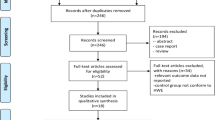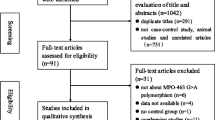Abstract
Paraoxonase is an HDL-associated enzyme that plays a preventive role against oxidative stress, which is thought to contribute to cancer development. PON1 activity varies widely among individuals, which is in part related to two common nonsynonymous polymorphisms in the PON1 gene (Q192R and L55M). The polymorphisms in PON1 have been implicated in cancer risk. However, results from the studies to date have been conflicting. To clarify the association, a meta-analysis was performed for 7,073 cases and 9,520 controls from 25 published case–control studies. Odds ratios (ORs) with 95% confidence intervals (CIs) were used to assess the strength of the association. Significant associations between PON1-L55M but not Q192R polymorphism and total cancer were observed from all the comparisons. In stratified analyses, PON1-55M allele was a risk factor for breast cancer. Similarly, increased risk was observed for prostate cancer (OR = 1.18, 95% CI: 1.01–1.36, P heterogeneity = 0.260) and Caucasian population (OR = 1.18, 95% CI: 1.02–1.38, P heterogeneity = 0.1) of the LM genotype, compared with the LL genotype. For PON1-Q192R polymorphism, PON1-192R allele was a decreased risk factor for cancer in the Asian group (RR vs QQ: OR = 0.61, 95% CI: 0.38–0.98, P heterogeneity = 0.268; QR vs QQ: OR = 0.71, 95% CI: 0.52–0.96, P heterogeneity = 0.130; RR + QR vs QQ: OR = 0.71, 95% CI: 0.53–0.95, P heterogeneity = 0.135). Although some modest bias could not be eliminated, this meta-analysis suggests that the PON1-55M allele is a risk factor for the development of cancer, in particular for breast cancer. Future studies with larger sample sizes are warranted to further evaluate these associations.


Similar content being viewed by others
References
Cejas P, Casado E, Belda-Iniesta C, De Castro J, Espinosa E, Redondo A, Sereno M, Garcia-Cabezas MA, Vara JA, Dominguez-Caceres A, Perona R, Gonzalez-Baron M (2004) Implications of oxidative stress and cell membrane lipid peroxidation in human cancer (Spain). Cancer Causes Control 15(7):707–719. doi:10.1023/B:CACO.0000036189.61607.52
Ames BN (1983) Dietary carcinogens and anticarcinogens. Oxygen radicals and degenerative diseases. Science 221(4617):1256–1264
Klaunig JE, Kamendulis LM (2004) The role of oxidative stress in carcinogenesis. Annu Rev Pharmacol Toxicol 44:239–267. doi:10.1146/annurev.pharmtox.44.101802.121851
Wiseman H, Halliwell B (1996) Damage to DNA by reactive oxygen and nitrogen species: role in inflammatory disease and progression to cancer. Biochem J 313(1):17–29
Stevens VL, Rodriguez C, Talbot JT, Pavluck AL, Thun MJ, Calle EE (2008) Paraoxonase 1 (PON1) polymorphisms and prostate cancer in the CPS-II nutrition cohort. Prostate 68(12):1336–1340. doi:10.1002/pros.20796
Humbert R, Adler DA, Disteche CM, Hassett C, Omiecinski CJ, Furlong CE (1993) The molecular basis of the human serum paraoxonase activity polymorphism. Nat Genet 3(1):73–76. doi:10.1038/ng0193-73
Davies HG, Richter RJ, Keifer M, Broomfield CA, Sowalla J, Furlong CE (1996) The effect of the human serum paraoxonase polymorphism is reversed with diazoxon, soman and sarin. Nat Genet 14(3):334–336. doi:10.1038/ng1196-334
Shih DM, Gu L, Xia YR, Navab M, Li WF, Hama S, Castellani LW, Furlong CE, Costa LG, Fogelman AM, Lusis AJ (1998) Mice lacking serum paraoxonase are susceptible to organophosphate toxicity and atherosclerosis. Nature 394(6690):284–287. doi:10.1038/28406
Aynacioglu AS, Cascorbi I, Mrozikiewicz PM, Nacak M, Tapanyigit EE, Roots I (1999) Paraoxonase 1 mutations in a Turkish population. Toxicol Appl Pharmacol 157(3):174–177. doi:10.1006/taap.1999.8690
Lurie G, Wilkens LR, Thompson PJ, McDuffie KE, Carney ME, Terada KY, Goodman MT (2008) Genetic polymorphisms in the Paraoxonase 1 gene and risk of ovarian epithelial carcinoma. Cancer Epidemiol Biomarkers Prev 17(8):2070–2077. doi:10.1158/1055-9965.EPI-08-0145
Mackness B, Mackness MI, Arrol S, Turkie W, Durrington PN (1997) Effect of the molecular polymorphisms of human paraoxonase (PON1) on the rate of hydrolysis of paraoxon. Br J Pharmacol 122(2):265–268. doi:10.1038/sj.bjp.0701390
Li WF, Costa LG, Richter RJ, Hagen T, Shih DM, Tward A, Lusis AJ, Furlong CE (2000) Catalytic efficiency determines the in-vivo efficacy of PON1 for detoxifying organophosphorus compounds. Pharmacogenetics 10(9):767–779
Leviev I, Negro F, James RW (1997) Two alleles of the human paraoxonase gene produce different amounts of mRNA. An explanation for differences in serum concentrations of paraoxonase associated with the (Leu-Met54) polymorphism. Arterioscler Thromb Vasc Biol 17(11):2935–2939
Leviev I, Deakin S, James RW (2001) Decreased stability of the M54 isoform of paraoxonase as a contributory factor to variations in human serum paraoxonase concentrations. J Lipid Res 42(4):528–535
Aksoy-Sagirli P, Cakmakoglu B, Isbir T, Kaytan-Saglam E, Kizir A, Topuz E, Berkkan H (2011) Paraoxonase-1 192/55 polymorphisms and the risk of lung cancer in a Turkish population. Anticancer Res 31(6):2225–2229
Gallicchio L, McSorley MA, Newschaffer CJ, Huang HY, Thuita LW, Hoffman SC, Helzlsouer KJ (2007) Body mass, polymorphisms in obesity-related genes, and the risk of developing breast cancer among women with benign breast disease. Cancer Detect Prev 31(2):95–101. doi:10.1016/j.cdp.2007.02.004
Searles Nielsen S, Mueller BA, De Roos AJ, Viernes HM, Farin FM, Checkoway H (2005) Risk of brain tumors in children and susceptibility to organophosphorus insecticides: the potential role of paraoxonase (PON1). Environ Health Perspect 113(7):909–913
Arpaci A, Gormus U, Dalan B, Berkman S, Isbir T (2009) Investigation of PON1 192 and PON1 55 polymorphisms in ovarian cancer patients in Turkish population. In Vivo 23(3):421–424
Antognelli C, Mearini L, Talesa VN, Giannantoni A, Mearini E (2005) Association of CYP17, GSTP1, and PON1 polymorphisms with the risk of prostate cancer. Prostate 63(3):240–251. doi:10.1002/pros.20184
Martinez C, Molina JA, Alonso-Navarro H, Jimenez-Jimenez FJ, Agundez JA, Garcia-Martin E (2010) Two common nonsynonymous paraoxonase 1 (PON1) gene polymorphisms and brain astrocytoma and meningioma. BMC Neurol 10:71. doi:10.1186/1471-2377-10-71
Handoll HH (2006) Systematic reviews on rehabilitation interventions. Arch Phys Med Rehabil 87(6):875. doi:10.1016/j.apmr.2006.04.006
Midgette AS, Wong JB, Beshansky JR, Porath A, Fleming C, Pauker SG (1994) Cost-effectiveness of streptokinase for acute myocardial infarction: a combined meta-analysis and decision analysis of the effects of infarct location and of likelihood of infarction. Med Decis Making 14(2):108–117
Lau J, Ioannidis JP, Schmid CH (1997) Quantitative synthesis in systematic reviews. Ann Intern Med 127(9):820–826
Egger M, Davey Smith G, Schneider M, Minder C (1997) Bias in meta-analysis detected by a simple, graphical test. BMJ 315(7109):629–634
Antognelli C, Del Buono C, Ludovini V, Gori S, Talesa VN, Crino L, Barberini F, Rulli A (2009) CYP17, GSTP1, PON1 and GLO1 gene polymorphisms as risk factors for breast cancer: an Italian case-control study. BMC Cancer 9:115. doi:10.1186/1471-2407-9-115
Uyar OA, Kara M, Erol D, Ardicoglu A, Yuce H (2011) Investigating paraoxonase-1 gene Q192R and L55M polymorphism in patients with renal cell cancer. Genet Mol Res 10(1):133–139. doi:10.4238/vol10-1gmr927
Rajaraman P, Hutchinson A, Rothman N, Black PM, Fine HA, Loeffler JS, Selker RG, Shapiro WR, Linet MS, Inskip PD (2008) Oxidative response gene polymorphisms and risk of adult brain tumors. Neuro Oncol 10(5):709–715. doi:10.1215/15228517-2008-037
Ozturk O, Kagnici OF, Ozturk T, Durak H, Tuzuner BM, Kisakesen HI, Cakalir C, Isbir T (2009) 192R allele of paraoxanase 1 (PON1) gene as a new marker for susceptibility to bladder cancer. Anticancer Res 29(10):4041–4046
Ergen A, Kilicoglu O, Ozger H, Agachan B, Isbir T (2011) Paraoxonase 1 192 and 55 polymorphisms in osteosarcoma. Mol Biol Rep 38(6):4181–4184. doi:10.1007/s11033-010-0538-8
Hussein YM, Gharib AF, Etewa RL, ElSawy WH (2011) Association of L55 M and Q192R polymorphisms in paraoxonase 1 (PON1) gene with breast cancer risk and their clinical significance. Mol Cell Biochem 351(1–2):117–123. doi:10.1007/s11010-011-0718-4
Lee CH, Lee KY, Choe KH, Hong YC, Kim YD, Kang JW, Kim H (2005) Effects of oxidative DNA damage induced by polycyclic aromatic hydrocarbons and genetic polymorphism of the paraoxonase-1 (PON1) gene on lung cancer. J Prev Med Public Health 38(3):345–350
Kerridge I, Lincz L, Scorgie F, Hickey D, Granter N, Spencer A (2002) Association between xenobiotic gene polymorphisms and non-Hodgkin’s lymphoma risk. Br J Haematol 118(2):477–481
Lincz LF, Kerridge I, Scorgie FE, Bailey M, Enno A, Spencer A (2004) Xenobiotic gene polymorphisms and susceptibility to multiple myeloma. Haematologica 89(5):628–629
Sun Y (1990) Free radicals, antioxidant enzymes, and carcinogenesis. Free Radic Biol Med 8(6):583–599
Karaman E, Uzun H, Papila I, Balci H, Ozdilek A, Genc H, Yanardag H, Papila C (2010) Serum paraoxonase activity and oxidative DNA damage in patients with laryngeal squamous cell carcinoma. J Craniofac Surg 21(6):1745–1749. doi:10.1097/SCS.0b013e3181f4040a
Elkiran ET, Mar N, Aygen B, Gursu F, Karaoglu A, Koca S (2007) Serum paraoxonase and arylesterase activities in patients with lung cancer in a Turkish population. BMC Cancer 7:48. doi:10.1186/1471-2407-7-48
Akcay MN, Polat MF, Yilmaz I, Akcay G (2003) Serum paraoxonase levels in pancreatic cancer. Hepatogastroenterology 50(2):ccxxv–ccxxvii
Akcay MN, Yilmaz I, Polat MF, Akcay G (2003) Serum paraoxonase levels in gastric cancer. Hepatogastroenterology 50(2):cclxxiii–cclxxv
Garin MC, James RW, Dussoix P, Blanche H, Passa P, Froguel P, Ruiz J (1997) Paraoxonase polymorphism Met-Leu54 is associated with modified serum concentrations of the enzyme. A possible link between the paraoxonase gene and increased risk of cardiovascular disease in diabetes. J Clin Invest 99(1):62–66. doi:10.1172/JCI119134
Naidu R, Har YC, Taib NA (2010) Genetic Polymorphisms of paraoxonase 1 (PON1) Gene: association Between L55 M or Q192R with breast cancer risk and clinico-pathological parameters. Pathol Oncol Res. doi:10.1007/s12253-010-9267-5
Minelli C, Thompson JR, Abrams KR, Thakkinstian A, Attia J (2005) The choice of a genetic model in the meta-analysis of molecular association studies. Int J Epidemiol 34(6):1319–1328. doi:10.1093/ije/dyi169
Ambrosone CB (2000) Oxidants and antioxidants in breast cancer. Antioxid Redox Signal 2(4):903–917
Delimaris I, Faviou E, Antonakos G, Stathopoulou E, Zachari A, Dionyssiou-Asteriou A (2007) Oxidized LDL, serum oxidizability and serum lipid levels in patients with breast or ovarian cancer. Clin Biochem 40(15):1129–1134. doi:10.1016/j.clinbiochem.2007.06.007
Author information
Authors and Affiliations
Corresponding author
Additional information
Dai-Hua Fang and Cong-Hai Fan are contributed equally to this work and should be considered as co-first authors.
Electronic supplementary material
Below is the link to the electronic supplementary material.
Rights and permissions
About this article
Cite this article
Fang, DH., Fan, CH., Ji, Q. et al. Differential effects of paraoxonase 1 (PON1) polymorphisms on cancer risk: evidence from 25 published studies. Mol Biol Rep 39, 6801–6809 (2012). https://doi.org/10.1007/s11033-012-1505-3
Received:
Accepted:
Published:
Issue Date:
DOI: https://doi.org/10.1007/s11033-012-1505-3




